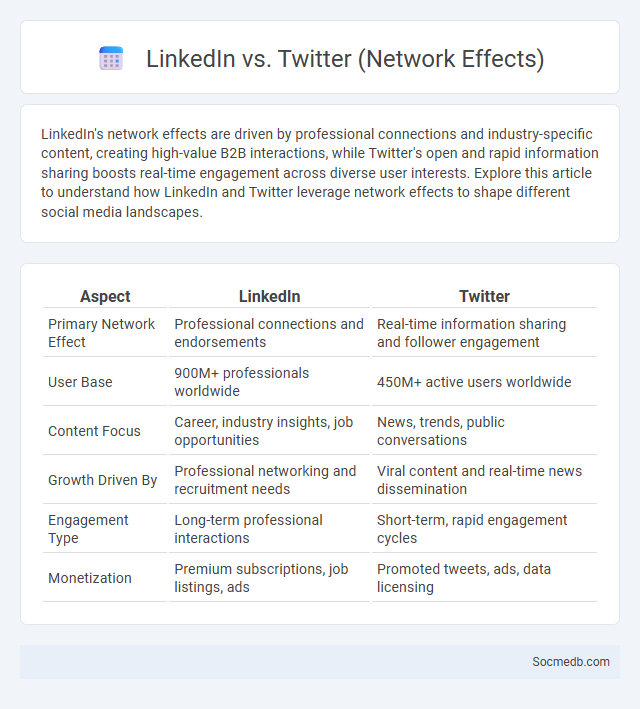
Photo illustration: LinkedIn vs Twitter (Network Effects)
LinkedIn's network effects are driven by professional connections and industry-specific content, creating high-value B2B interactions, while Twitter's open and rapid information sharing boosts real-time engagement across diverse user interests. Explore this article to understand how LinkedIn and Twitter leverage network effects to shape different social media landscapes.
Table of Comparison
| Aspect | ||
|---|---|---|
| Primary Network Effect | Professional connections and endorsements | Real-time information sharing and follower engagement |
| User Base | 900M+ professionals worldwide | 450M+ active users worldwide |
| Content Focus | Career, industry insights, job opportunities | News, trends, public conversations |
| Growth Driven By | Professional networking and recruitment needs | Viral content and real-time news dissemination |
| Engagement Type | Long-term professional interactions | Short-term, rapid engagement cycles |
| Monetization | Premium subscriptions, job listings, ads | Promoted tweets, ads, data licensing |
Introduction to Network Effects
Network effects occur when the value of a social media platform increases as more users join and engage. Your experience improves because each additional connection enhances communication, content diversity, and information sharing. Understanding network effects is crucial for maximizing social media influence and growth.
Understanding LinkedIn’s Network Effects
LinkedIn's network effects amplify the value of your professional connections by increasing visibility and opportunities as your network grows. Each new connection enhances the platform's utility by expanding access to industry insights, job openings, and potential collaborators. Leveraging these network effects strategically can accelerate career growth and influence within your sector.
Exploring Twitter’s Network Effects
Twitter's network effects amplify your social media experience by connecting millions of users who generate real-time content, trends, and conversations. Each new user increases the platform's value by creating more interactions, retweets, and follows, fostering a dynamic ecosystem where information spreads rapidly. This interconnectedness enhances your ability to access diverse opinions, engage with influencers, and stay informed on global events.
Direct Network Effects on LinkedIn
LinkedIn's user base growth significantly enhances its value by amplifying Direct Network Effects, where each new member increases connectivity and communication opportunities for all users. The platform's professional networking experience becomes more robust as users can directly connect with colleagues, recruiters, and industry experts, driving engagement and content relevance. This self-reinforcing cycle strengthens LinkedIn's position as the leading career-oriented social network, boosting user retention and advertising revenue.
Direct Network Effects on Twitter
Direct network effects on Twitter amplify user engagement as each new follower increases the value of the platform by expanding Your reach and potential interactions. The more users join and actively participate, the richer the content ecosystem becomes, driving higher levels of real-time communication and trend formation. This self-reinforcing cycle boosts visibility, influence, and community growth, making Twitter a dynamic hub for social connectivity.
Indirect and Data Network Effects
Social media platforms thrive on indirect network effects, where the value of the platform increases as more users join and create diverse content, attracting even more participants. Data network effects amplify this by using user interactions and personal data to refine algorithms, enhancing content relevance and user engagement. Your experience improves exponentially as these interconnected effects grow, making the platform more valuable and personalized over time.
Comparison: LinkedIn vs Twitter Network Effects
LinkedIn's network effects thrive on professional connections, driving value through shared industry insights and job opportunities, which attract users seeking career growth and B2B engagement. Twitter excels with rapid information dissemination and real-time conversations, fostering widespread user interaction across diverse interests and breaking news events. Both platforms leverage their unique network structures to maximize user engagement but cater to fundamentally different communication and community-building needs.
Impact of Network Effects on User Growth
Network effects significantly accelerate user growth on social media platforms by increasing the value of the service as more people join and engage. Your experience improves with the expanding network, offering enhanced connections, content variety, and interaction opportunities that attract even more users. This positive feedback loop creates a powerful growth engine, driving widespread adoption and sustained platform success.
Platform Engagement and Retention Dynamics
Social media platform engagement is driven by personalized content algorithms that boost user interaction rates by up to 30%. Retention dynamics hinge on continuous feature updates and community building, which increase monthly active user retention by approximately 25%. Effective engagement strategies leverage data analytics and user behavior patterns to sustain long-term platform loyalty.
Future Outlook: Evolving Network Effects on Social Platforms
Social media platforms will increasingly leverage evolving network effects to enhance user engagement, where the value of the platform grows as more users join and interact. Your experience will be shaped by advanced algorithms that personalize content delivery, fostering deeper connections and triggering viral trends faster than ever before. This continuous evolution drives platforms to innovate features that capitalize on social interactions, ensuring sustained growth and relevance in the digital landscape.
 socmedb.com
socmedb.com